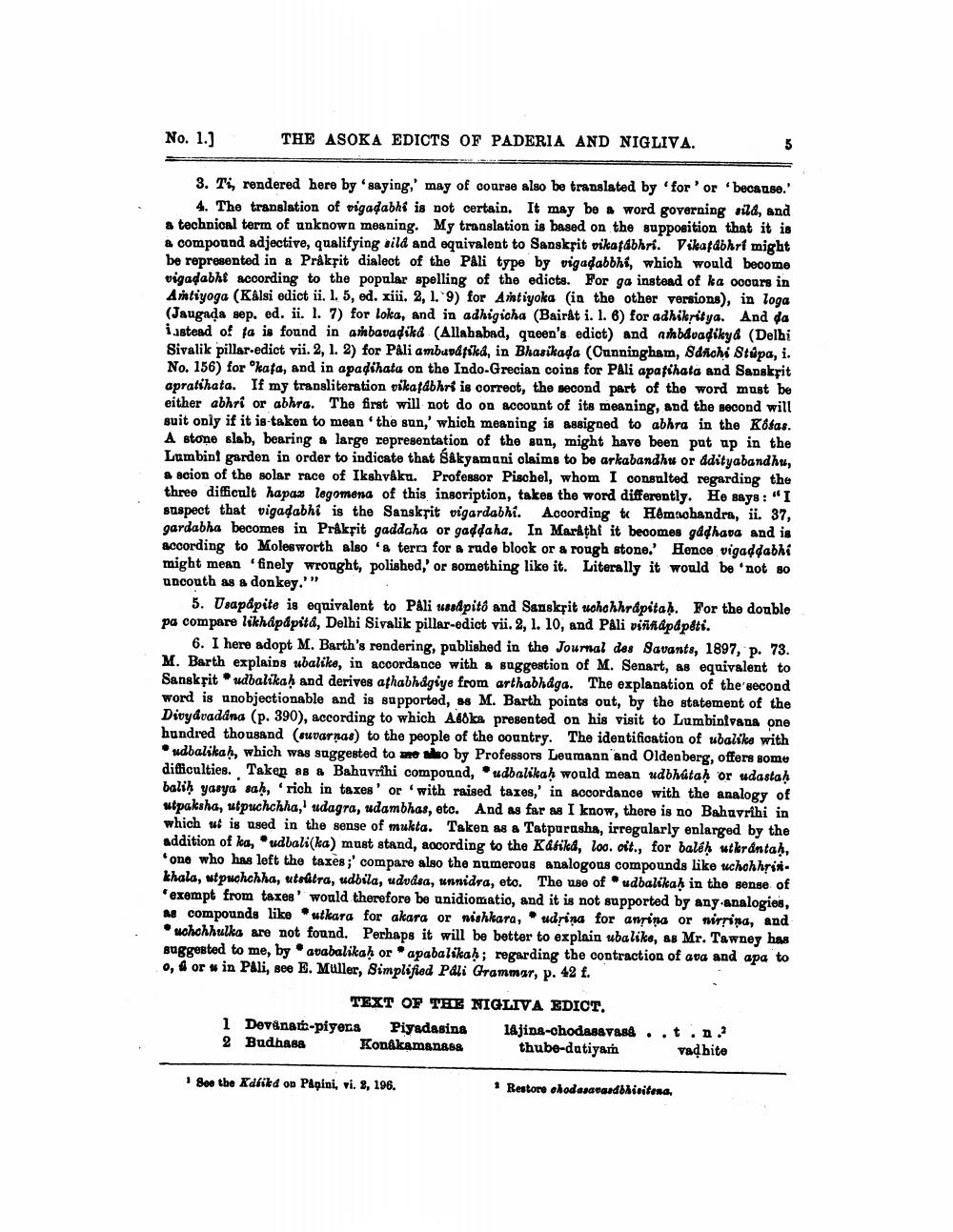________________
No. 1.)
THE ASOKA EDICTS OF PADERIA AND NIGLIVA.
3. Ti, rendered here by saying,' may of course also be translated by 'for' or 'because.'
4. The translation of vigadabhi is not certain. It may be a word governing wild, and a technical term of unknown meaning. My translation is based on the supposition that it is & compound adjective, qualifying aild and equivalent to Sanskrit vikafabhri. Vikafabhrí might be represented in a Pråkpit dialect of the Pali type by vigadabbhi, which would become vigadabht according to the popular spelling of the edicts. For ga instead of ka ooours in Amtiyoga (Kálsi edict ii. 1. 5, ed. xiii. 2, 1. 9) for Antiyoka (in the other versions), in loga (Jaugada sep. ed. ii. 1. 7) for Loka, and in adhigicha (Bairát i. 1. 6) for adhikritya. And da i jstead of fa is found in ambavadika (Allahabad, queen's edict) and athbavadiky& (Delhi Sivalik pillar-edict vii. 2, 1. 2) for Pali ambupatika, in Bhasikada (Canningham, Sdnichi Stúpa, i. No. 156) for "kata, and in apadihata on the Indo-Grecian coins for PAli apatihata and Sanskrit apratihata. If my transliteration vikafabhra is correct, the second part of the word must be either abhri or abhra. The first will not do on account of its meaning, and the second will suit only if it is taken to mean the sun,' which meaning is assigned to abhra in the Kotas. A stone slab, bearing a large representation of the sun, might have been put up in the Lambini garden in order to indicate that såkyamani claims to be arkabandhu or adityabandhu, a acion of the solar race of Ikshváku. Professor Pischel, whom I consulted regarding the three difficult hapaz legomena of this insoription, takes the word differently. He says: "I suspect that vigadabhi is the Sanskrit vigardabhi. According to Hémachandra, ii. 37, gardabha becomes in Prakfit gaddaha or gaddaha. In Marathi it becomes gddhava and is according to Molesworth also a terra for & rude block or a rough stone. Hence vigaddabhi might mean 'finely wrought, polished,' or something like it. Literally it would be 'not so uncouth as a donkey."
5. Usapåpite is equivalent to PAli usadpito and Sanskrit uchchhrápita). For the double pa compare likhápåpita, Delhi Sivalik pillar-edict vii. 2, 1. 10, and PAli viññáp&péts.
6. I here adopt M. Barth's rendering, published in the Journal dos Savants, 1897, p. 73. M. Barth explains ubalike, in accordance with a suggestion of M. Senart, as equivalent to Sanskrit udbalikaḥ and derives athabhágiye from arthabhága. The explanation of the second word is unobjectionable and is supportod, 88 M. Barth points out, by the statement of the Divydvadana (p. 390), according to which A.88ka presented on his visit to Lumbinivana one hundred thousand (suvarnas) to the people of the country. The identification of ubaliks with * udbalikah, which was suggested to me to by Professors Leumann and Oldenberg, offers some difficulties. Taken as a Bahuvrihi compound, *udbalikah would mean udbhata) or udastaḥ balih yasya sah, rich in taxes' or with raised taxes,' in accordance with the analogy of utpaksha, utpuchchha, udagra, udambhas, etc. And as far as I know, there is no Bahavrihi in which wt is used in the sense of mukta. Taken as a Tatparasha, irregularly enlarged by the addition of ka, "udbali(ka) must stand, according to the Kafika, loo. ait, for baléh utkrantah,
one who has left the taxes;' compare also the numerous analogous compounds like uchchhris. khala, utpuchchha, utadtra, udbila, ududsa, unnidra, eto. The use of udbalikaḥ in the sense of
exempt from taxes' would therefore be unidiomatio, and it is not supported by any analogies, As compounds like utkara for akara or mishkara, • udrina for anrina or wirripa, and * uchchhulka are not found. Perhaps it will be better to explain ubalike, as Mr. Tawney has suggested to me, by avabalikah or apabalikah; regarding the contraction of ata and apa to o, or win PAli, see E. Muller, Simplified Pali Grammar, p. 42 f.
TEXT OF THE NIGLIVA EDICT. 1 Devana-piyona Piyadasina Ajina-chodasavas ..t.n.3 2 Budhasa Konakamanasa thube-datiyam vadhite
See the Kdliká op Papini, vi. 3, 196.
• Restore chodesacerddhistens,




